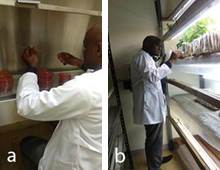| We used the plant infection technique to estimate the population of rhizobia in soils obtained from the Montane and Mt. Elgon agro-ecological zones (AEZs), focusing on three land use management practices across an elevation gradient. There were larger numbers of bean-nodulating bacteria (shown by the MPN range) in cultivated land as compared to forest and grassland (Table 1). |  |
|
With a minimum of 20 isolates per soil sample, 500 isolations were made from bean nodules. The following colony morphologies were observed; white, opaque and raised (70%) and white, translucent and raised (30%) with a colony diameter ranging from 1.0-2.0 mm after 2-3 days. Less than 10 colonies had a colony diameter ranging from 3.0-4.0 mm. The isolates were stored in a broth-glycerol mixture for further work and also used in subsequent authentication experiments. From the authentication experiments under sterile conditions in a growth chamber for 133 isolates, 244 out of 266 duplicate runs generated a positive authentication giving a nodulation efficiency of 91.7%. Future work will involve DNA sequencing and effectiveness tests of the isolates in comparison with commercial inoculants. |
Figure 1. (a) Isolation of rhizobia on YEMA-CR media and (b) sterile nutrient solution addition during authentication tests of the isolates in a growth chamber
|
Allan Ochieng, Wageningen University, The Netherlands (Click here for his 2015 update)

